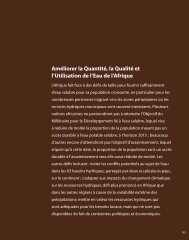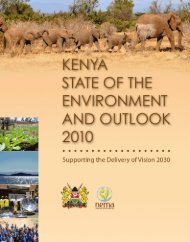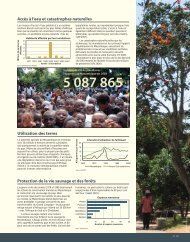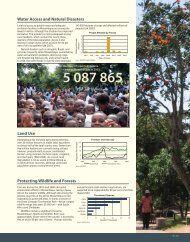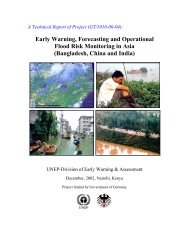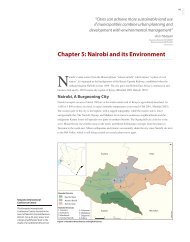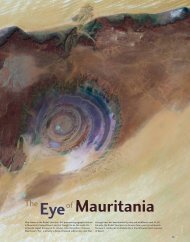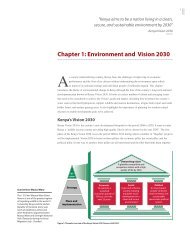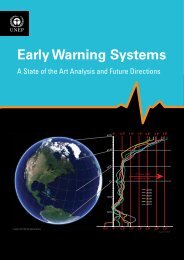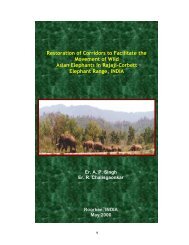Uganda Atlas of Our Changing Environment - GRID-Arendal
Uganda Atlas of Our Changing Environment - GRID-Arendal
Uganda Atlas of Our Changing Environment - GRID-Arendal
Create successful ePaper yourself
Turn your PDF publications into a flip-book with our unique Google optimized e-Paper software.
Transboundary and cross-border environmental issues<br />
Chapter 3<br />
Transboundary and cross-border environmental issues in <strong>Uganda</strong><br />
The source <strong>of</strong> River Nile at Jinja. The River Nile leaves Lake Victoria at Jinja. The tributaries <strong>of</strong> the Nile flow through nine countries in Africa into the Mediterranean Sea.<br />
Distribution <strong>of</strong> natural resources and biodiversity<br />
oes not respect boundaries, which makes their<br />
management <strong>of</strong> transboundary in character.<br />
<strong>Uganda</strong> shares boundaries with Kenya, Tanzania,<br />
Democratic Republic <strong>of</strong> Congo, Rwanda and Sudan. Many<br />
protected areas, rivers, lakes in <strong>Uganda</strong> are shared with<br />
these countries. For example one <strong>of</strong> the longest river<br />
in Africa, the Nile and is shared by many countries has<br />
its source in <strong>Uganda</strong>. Furthermore, <strong>Uganda</strong> now has 80<br />
districts and many ecosystems are shared among districts<br />
which calls for increased collaborative efforts to manage<br />
these resources. <strong>Uganda</strong> has signed several agreements<br />
with its neighbors to manage some <strong>of</strong> these resources.<br />
The Nile Basin Initiative (NBI) is a partnership initiated<br />
and led by the riparian states <strong>of</strong> the Nile River through<br />
the Council <strong>of</strong> Ministers <strong>of</strong> Water Affairs <strong>of</strong> the Nile Basin<br />
states (Nile Council <strong>of</strong> Ministers, or Nile-COM). The NBI<br />
seeks to develop the river in a cooperative manner, share<br />
substantial socioeconomic benefits, and promote regional<br />
peace and security.<br />
Lake Victoria is also another resource where <strong>Uganda</strong> has<br />
gone into partnership with its neighbors to manage it<br />
sustainably. The East African Community has designated<br />
Lake Victoria and its Basin as an “area <strong>of</strong> common<br />
economic interest” and a “regional economic growth<br />
zone” to be developed jointly by the Partner States.<br />
And Lake Victoria is the focus <strong>of</strong> new attention following<br />
the declaration by the East African Community Heads<br />
<strong>of</strong> State that a joint programme be developed for the<br />
overall management and rational utilization <strong>of</strong> the<br />
shared resources <strong>of</strong> the lake.<br />
The East African Community established the Lake<br />
Victoria Development Programme in 2001, as a<br />
mechanism for coordinating the various interventions<br />
on the Lake and its Basin; and serving as a centre for<br />
promotion <strong>of</strong> investments and information sharing among<br />
the various stakeholders. Currently there is the Lake<br />
Victoria commission that became effective in 2005 with<br />
its headquaters at Kisumu. It is the apex institution <strong>of</strong><br />
EAC mandated with overall coordination.<br />
133<br />
NEMA 2008



